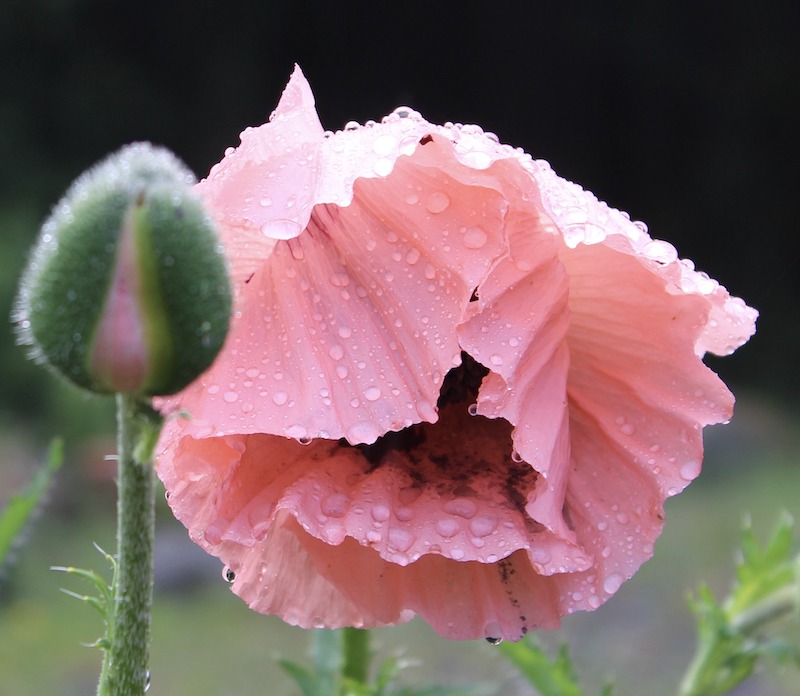All types of Poppies are drought tolerant and make a great addition to a water-wise gardening scheme. Regular supplemental watering is usually only needed when seedlings emerge and after planting container-grown plants. Poppies planted in containers may need more watering, depending on what zone you garden in, but will still need to dry out a bit in between watering.

How To Tell If Poppies Need To Be Watered
Poppies have foliage that adapts to periods of drought much easier than other perennials. Oriental and Meconopsis Poppies have hairy stems and flower pods that help to reduce moisture loss through transpiration as well as deter deer or other wildlife from browsing. Other Poppies, Icelandic Poppies and California Poppies, have foliage that is lighter green or even silvery in color to help reflect strong sunlight and protect the plant from moisture loss due to high heat.
When these adaptations fail, Poppies will develop yellowing leaves, leaf tips that turn brown and crispy, or floppy stems. Unfortunately, these are also signs that the plant may be overwatered. Overwatering is easy to do when Poppies are planted in garden beds or containers among other plants that need more watering.

How Often To Water Poppies
Planting Poppies in the spring, while rain is still plentiful, ensures that the plants will establish well with little extra irrigation. Newly planted Poppy plants will need ½ -1 inch of rain per week. Seedling Poppies will need more consistent watering until they start to form flower buds. Spring-sown poppies need 1 inch of water every week, split into 3 sessions to keep the soil moist enough for the seeds to germinate and put on rapid growth.
Perennial Poppies will need additional waterings only during periods of high heat or drought. The plants only require around ½ inch of water every 10 -14 days if there has been no natural rainfall. Most Poppies are ready to go dormant as the heat of summer arrives. They will begin to turn brown, die back, and put all of their energy into ripening seeds. All supplemental watering should stop if you are interested in saving the seed.
Overwatering Poppies is the number one mistake that gardeners make. Poppies do not like to have too much extra watering or to sit in waterlogged soils. An overwatered plant can sometimes be revived by moving it to a site with better drainage or restricting the amount of extra water it gets. Using drip irrigation and soaker hoses are better ways to water Poppies than overhead watering. The water goes right to the root zone and does not get the foliage wet.
Container-grown Poppies need a period of drying out to ensure that the potting soil does not stay wet, rotting the roots. Let the top 3 inches of soil dry out before watering. Water well until it comes out of the bottom of the pot. Make sure that plants planted in the same container as poppies have the same water requirements.

Best Time To Water Poppies
Watering early in the day is the best time for almost all plants. The soil will be cooler, even a bit damp from heavy dew, helping to reduce evaporation. Any plants that are splashed with water have the whole day to dry off, reducing risk of mildews and diseases that thrive on damp plants. Many Poppies bloom in the spring and early summer when the weather may be cooler. Cooler weather will also help the soil retain moisture longer. Watering during the fall or winter while the plant is dormant is not necessary. Dormant plants do not need supplemental watering.
How to Water Poppies
Step 1 - Water only if the plants are newly planted
Poppies need regular watering while young to establish good root systems.
Step 2 - Water established Poppies ½ -1 inch of water every week - 10 days.
Infrequent but long periods of watering will establish deeper roots that withstand drought better.
Step 3 - Seeded Poppies need regular watering until they germinate and start to form flower buds
Water at least 1 inch of water per week, divided into 3 or more sessions, until the seeds are germinated and the plant is forming flower buds.
Step 4 -Potted Poppies need to dry out in between waterings
Soak the containers until water comes out the bottom of the pot, ensuring that all of the potting soil is evenly moist. Letting the soil dry out in between sessions will ensure that the roots never sit in water longer than they like.
Poppy Watering Tips
- Poppies need little supplemental watering
- Infrequent watering for longer periods will help roots to establish deep in the ground
- Poppies have natural adaptations to their stems and leaves that help to reduce moisture loss
- Container-grown Poppies need to dry out in between waterings
 |
Author Robbin Small - Published 7-26-2022 |
